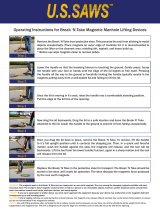
Before leaving the operator’s seat:
Move the machine to a level surface.
Lower the machine.
Set the parking brake.
If the machine is equipped with a
transmission, place the gearshift in
neutral.
Reduce the engine speed.
Stop the engine and remove the key.
Disengage the drive to each attachment
except when operating the machine.
Set the parking brake, stop the engine,
disengage the drive to each attachment, and
remove the key under the following
conditions:
Before refueling
Before adjusting the machine
Before removing blockages
Before checking, cleaning, or servicing the
machine
After striking a foreign object or
experiencing an abnormal vibration while
operating the machine
When turning the engine off, close the
throttle and then close the fuel valve if your
model is equipped with one.
Close the fuel valve before transporting the
machine.
Take care when loading or unloading the
machine onto a trailer or a truck. Load or
unload the machine in a flat and safe place.
Before loading or unloading, set the parking
brake on the truck or trailer, stop the engine,
and chock the wheels.
When transporting the machine on a truck or
a trailer, set the parking brake, stop the
engine, and fasten the machine to the truck
with a rope or other suitable restraining
device that has sufficient strength.
When using a running board, select one with
sufficient strength, length, and width and that
will not cause the machine to slip.
Maintenance and storage
Before servicing or adjusting the machine,
move the machine to a flat area, set the
parking brake, turn the engine off, and then
remove the key. Be sure to check that each
part has completely stopped operating
before servicing or adjusting the machine.
20.
[1]
[2]
[3]
[4]
[5]
[6]
21.
22.
[1]
[2]
[3]
[4]
[5]
23.
24.
25.
26.
27.
1.
Before servicing or adjusting the machine,
be sure to disconnect the battery. To remove
the battery, disconnect the negative battery
cable first. To install the battery, connect the
positive battery cable first.
To prevent a fire, keep the engine, muffler,
and battery areas free of excessive grease,
grass, leaves, and dust.
Make sure that parts such as wires are not
touching each other and that their covers
have not come off.
When filling the tires with air, do not allow
the air pressure in the tires to exceed the
specified maximum.
Check that all nuts, bolts, and screws are
properly tightened to ensure that the
machine is always operated under safe
conditions.
Check whether all parts of the machine are
in good working condition.
Check whether line connectors in the
hydraulic system are properly tightened.
Before applying hydraulic pressure, check
the connections of the hydraulic pressure
lines and the condition of the hoses.
Do not modify the machine.
Take care that your fingers do not get
crushed while servicing or making
adjustments to the machine.
Keep hands and feet away from moving
parts. If possible, avoid making any
adjustments while the engine is running. Do
not allow people to approach the machine’s
surroundings.
Take care when removing equipment that
may have pressure such as that from a
spring applied to it.
Be sure to depressurize the hydraulic system
before performing maintenance operations
on it such as removing hydraulic equipment.
When checking the hydraulic circuit for
pinhole leaks or oil leakage from nozzles, do
not use your hands. Use items such as
paper or corrugated cardboard to find
leakage points. Be extremely careful with
high-pressure oil as it may pierce your skin,
resulting in an injury.
Do not change the engine governor setting
or operate the engine at a speed higher than
this setting. Check the maximum engine
speed using a tachometer.
2.
3.
4.
5.
6.
7.
8.
9.
10.
11.
12.
13.
14.
15.
Safety
Page 1-4
Safety instruction























